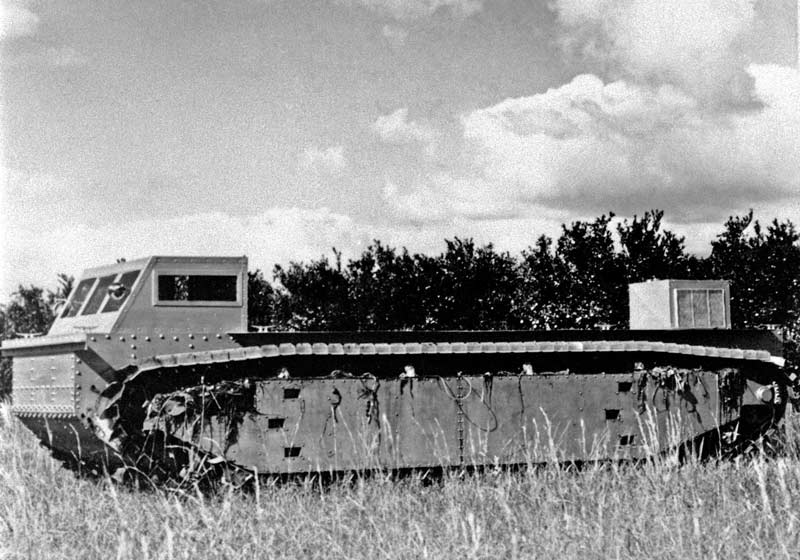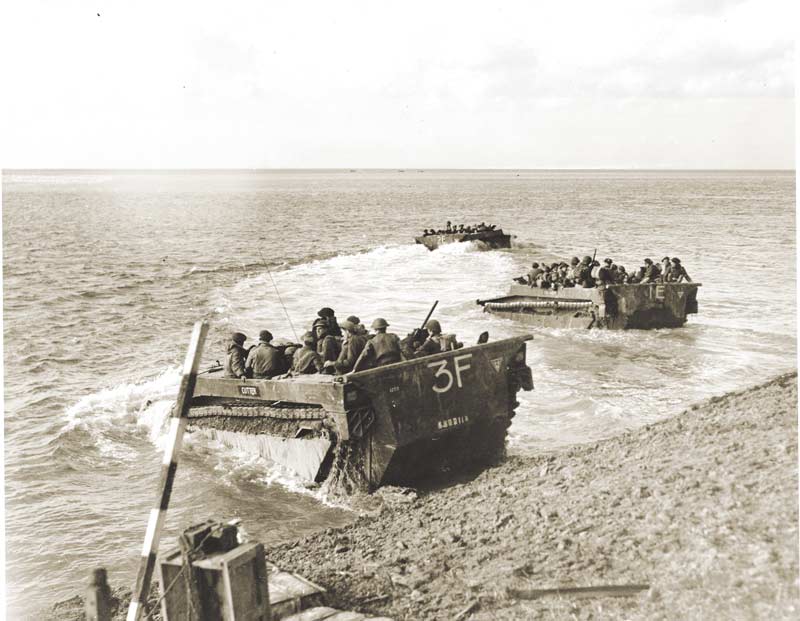
The military design was based on the Roebling Alligator, which was used for civilian rescues. [Alamy/2A9EHRK]
Eccentric inventor Donald Roebling moved to Florida during the calm between horrible hurricanes in the 1920s and ’30s that had claimed thousands of lives and had left many people lost or awaiting rescue.
Roebling developed the Alligator, an amphibious rescue vehicle so promising it was featured in a photo essay in Life magazine in October 1937.
Large enough to hold 40 people, it moved through the water at 2.5 kilometres per hour and its cupped metal treads grabbed sandy beaches and crawled over muddy banks. It could easily mount seaside berms, chew through trees and shrubs and claw through loose soil.
The U.S. military saw the article in Life and thought the Alligator might make a dandy landing craft. A beefed-up version, called the Landing Vehicle, Tracked (LVT) was produced, tested and ready before the U.S. entered the Second World War in December 1941.

Buffaloes full of Canadian soldiers land in the Netherlands. [Donald I. Grant/DND/LAC/PA-136754]

The W design of the track helped the vehicle navigate mud and sand.[Sharon Adams/LM]
More than 18,000 LVTs were used by the American, Canadian and British armies to transport cargo, carry assault troops and evacuate casualties. Some were armed with 20mm cannons, machine guns and flame-throwers.
British and Canadian troops mostly used the LVT-2 or LVT-4 Water Buffalo. Slow but sturdy, the Buffalo’s high sides protected troops as it moved through waterways, climbed high banks and crossed muddy fields. The Buffalo proved particularly useful in the Battle of the Scheldt.
“Canadians were faced with…trying to slosh through the sodden, often flooded, beet fields or attack along the tops of the dikes.” —Charles P. Stacey
In September 1944, the Allies had captured the port of Antwerp, which was vital to supply their push to end the war. But the Germans still held the territory to the north up the Scheldt River. They had breached the dikes, flooded the polders (land reclaimed from the sea), and dug in.
“Off the roads, movement even by infantry was difficult; movement by vehicles was impossible,” said Charles P. Stacey in the Official History of the Canadian Army in the Second World War. Troops were easy targets on shorelines, the soggy, flat land in the area and on roads running along the top of dikes.
Buffaloes provided a way to land a large number of troops for an attack.
A week of intense fighting at the Leopold Canal in early October exposed a weakness on the German flank. The action was heightened to provide a distraction as troops from the North Nova Scotia Highlanders and the Highland Light Infantry of Canada were loaded into 48 amphibious trucks and Buffaloes for an attack on the weak point.
In the dead of night on Oct. 9, the first Buffaloes “waddled down the ramp and splashed into the water,” reported Lieutenant-Commander Robert D. Franks. He expected they would be discovered since the slow-moving vehicles had a shrieking engine that broadcast their movement along the seven-kilometre route down the canal and across an inlet. But noise from shelling covered the sound.
Covered by smoke and an artillery barrage, the Buffaloes landed safely. They crossed a mud flat, a picket-studded slope, a dike and a wide drainage ditch, then offloaded men, Jeeps, carriers and anti-tank guns near the Dutch village of Hoofdplaat at the German rear.
The Canadians advanced 1,500 metres before they were discovered, an edge that allowed them to fight through and liberate Hoofdplaat and create a spearhead that permitted following troops to press farther inland.
BY THE NUMBERS
(LVT-2 Water Buffalo)
2,900 – Payload in kilograms
24 – Number of fully equipped troops per load
32 –Top land speed in kilometres per hour
10 –Top water speed in kilometres per hour
Advertisement


















